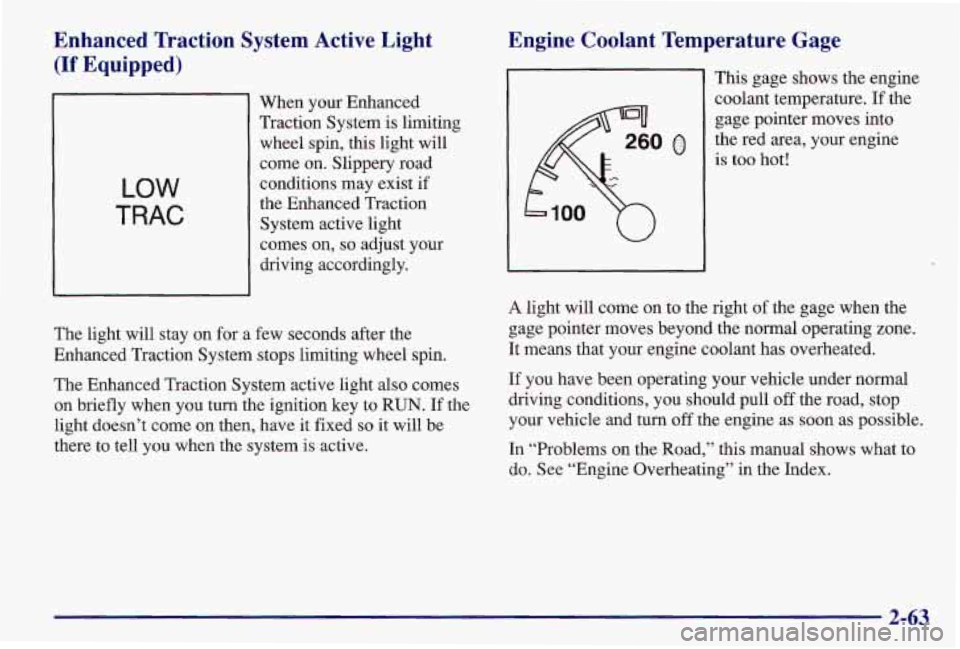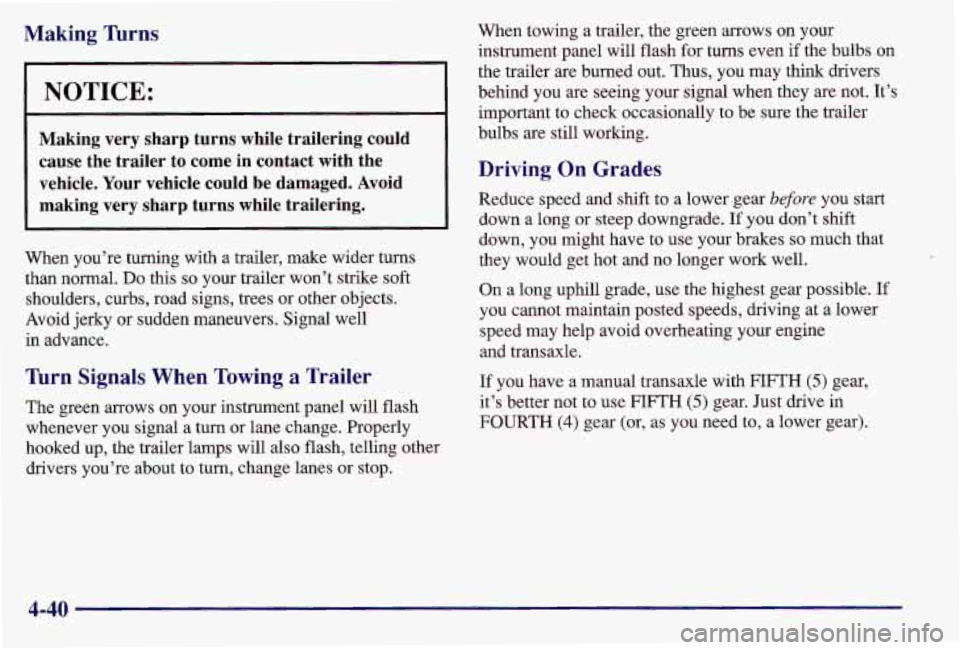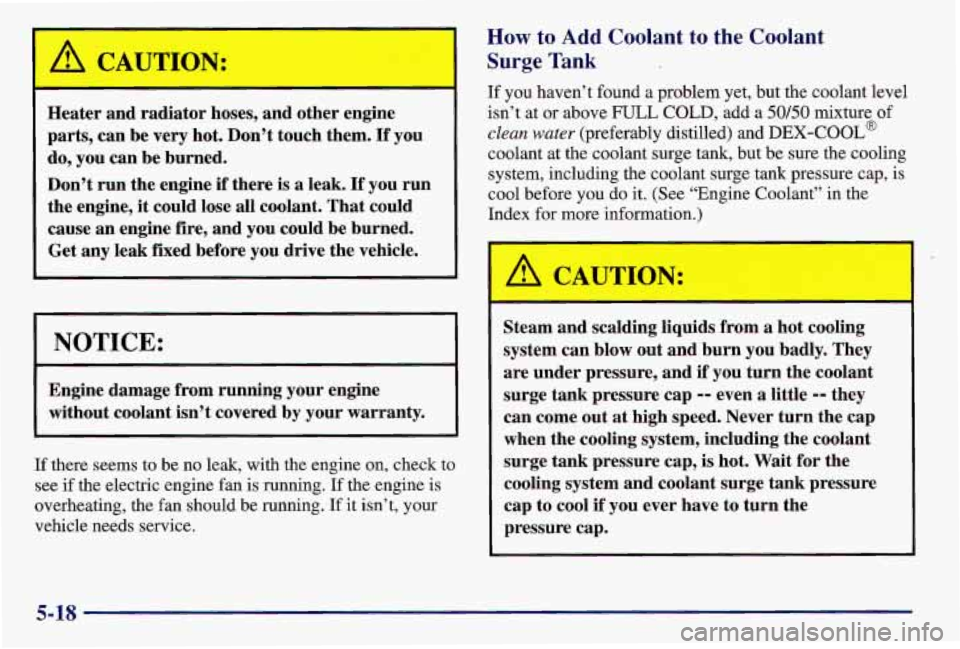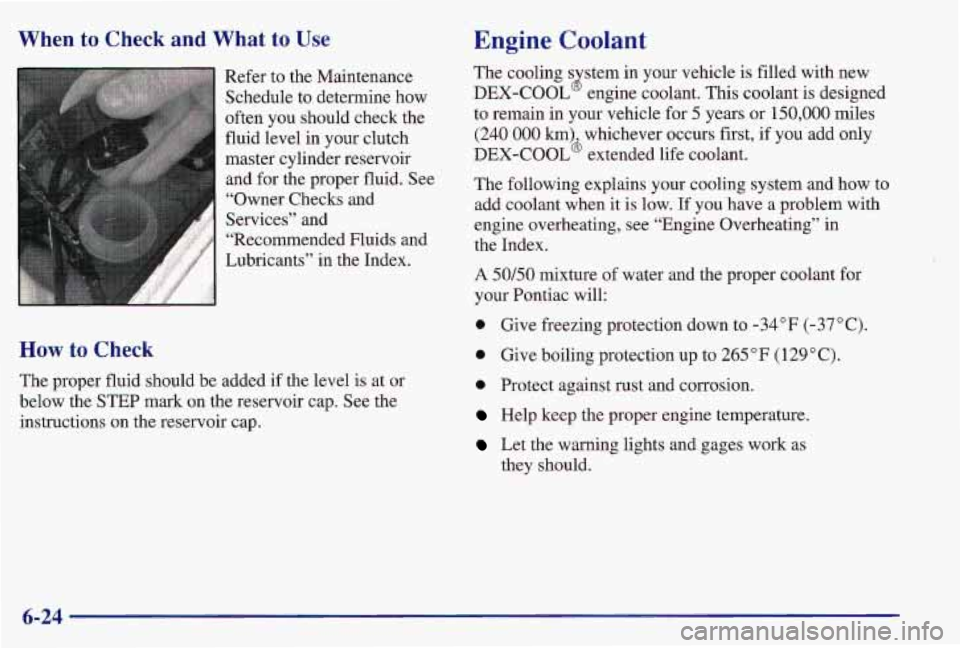Page 118 of 371

Enhanced Traction System Active Light
(If Equipped)
LOW
TRAC
When your Enhanced
Traction System is limiting
wheel spin, this light will
come on. Slippery road
conditions may exist if
the Enhanced Traction
System active light
comes on,
so adjust your
driving accordingly.
The light will stay on for a
few seconds after the
Enhanced Traction System stops limiting wheel spin.
The Enhanced Traction System active light also comes
on briefly when you turn the ignition key to RUN, If the
light doesn’t come on then, have it fixed
so it will be
there to tell you when the system is active.
Engine Coolant Temperature Gage
This gage shows the engine
coolant temperature.
If the
gage pointer moves into
the red area, your engine
is too hot!
A light will come on to the right of the gage when the
gage pointer moves beyond the normal operating zone.
It means that your engine coolant has overheated.
If you have been operating your vehicle under normal
driving conditions, you should pull off the road, stop
your vehicle and turn off the engine as soon as possible.
In “Problems on the Road,” this manual shows what to
do. See “Engine Overheating” in the Index.
2-63
Page 119 of 371

Low Coolant Warning Light
If this light comes on and
stays on, the vehicle should
be promptly pulled off the
road and the coolant level
checked. See “Engine
Coolant” in the Index.
If there are visible signs of steam see “Engine
Overheating” in the Index before opening the hood.
Malfunction Indicator Lamp
(Check Engine Light)
Your Pontiac is equipped
with a computer which
monitors operation
of the
fuel, ignition and emission
CHECK
ENGINE
This system is called OBD I1 (On-Board
Diagnostics-Second Generation) and is intended to
assure that emissions are at acceptable levels for the life
of the vehicle, helping to produce a cleaner
environment. (In Canada, OBD
I1 is replaced by
Enhanced Diagnostics.) The CHECK
ENGINE light
comes on
to indicate that there is a problem and service
is required. Malfunctions often will be indicated by the
system before any problem is apparent. This may
prevent more serious damage to your vehicle.
This
system is also designed to assist your service technician
in correctly diagnosing
any malfunction.
2-64
Page 191 of 371

Making Turns
I NOTICE: 1
Making very sharp turns while trailering could cause the trailer to come in contact with the vehicle. Your vehicle could be damaged. Avoid
making very sharp turns while trailering.
1
When you’re turning with a trailer, make wider turns
than normal.
Do this so your trailer won’t strike soft
shoulders, curbs, road signs, trees or other objects.
Avoid jerky or sudden maneuvers. Signal well
in advance.
Turn Signals When Towing a Trailer
The green arrows on your instrument panel will flash
whenever you signal a turn or lane change. Properly
hooked up, the trailer lamps will also flash, telling other
drivers you’re about to turn, change lanes
or stop. When
towing a trailer, the green arrows on your
instrument panel will flash for turns even
if the bulbs on
the trailer are burned out. Thus, you may think drivers
behind you are seeing your signal when they are not. It’s
important
to check occasionally to be sure the trailer
bulbs are still working.
Driving On Grades
Reduce speed and shift to a lower gear before you start
down a long or steep downgrade.
If you don’t shift
down, you might have to use your brakes
so much that
they would get hot and no longer work well.
On a long uphill grade, use the highest gear possible. If
you cannot maintain posted speeds, driving at a lower
speed may help avoid overheating your engine
and transaxle.
If you have a manual transaxle with FIFTH
(5) gear,
it’s better not to use FIFTH
(5) gear. Just drive in
FOURTH
(4) gear (or, as you need to, a lower gear).
4-40
Page 194 of 371
Section 5 Problems on the Road
Here you’ll find what to do about some problems that can occur on the road.
5-2 Hazard Warning Flashers
5-2 Other Warning Devices
5-3 Jump Starting
5- 8 Towing Your Vehicle
5- 14 Engine Overheating
5-22
5-23
5-33
5-34
If a Tire Goes Flat
Changing a Flat Tire
Compact Spare Tire
If You’re Stuck: In Sand, Mud,
Ice or Snow
5-1
Page 207 of 371
Engine Overheating
You will find a coolant temperature gage and a low
coolant warning light on your Pontiac’s instrument
panel. See “Engine Coolant Temperature Gage”
and
“Low Coolant Warning Light” in the Index.
If Steam Is Coming From Your Engine
A CAUTION:
I
Steam from an overheated engine can burn you
badly, even if you just open the hood. Stay away
from the engine if you see or hear steam coming
from it. Just turn it off and get everyone away
from the vehicle until it cools down. Wait until
there is no sign of steam or coolant before
you
open the hood.
If you keep driving when your engine is
overheated, the liquids in it can catch fire.
You or
others could be badly burned. Stop your engine
if
it overheats, and get out of the vehicle until the
engine is cool.
NOTICE:
If your engine catches fire because you keep
driving with no coolant, your vehicle can be
badly damaged. The costly repairs would not be covered
by your warranty.
Page 211 of 371

/11 CAUTION:
I
Heater and radiator hoses, and other engine
parts, can be very hot. Don’t touch them.
If you
do, you can be burned.
Don% run the engine
if there is a leak. If you run
the engine,
it could lose all coolant. That could
cause an engine fire, and you could
be burned.
Get any leak fixed before you drive the vehicle.
I NOTICE:
.
Engine damage from running your engine
without coolant isn’t covered by your warranty.
If there seems to be no leak, with the engine on, check to
see if the electric engine fan is running. If the engine is
overheating, the fan should be running. If it isn’t, your
vehicle needs service.
How to Add Coolant to the Coolant
Surge Tank
If you haven’t found a problem yet, but the coolant level
isn’t at or above
FULL COLD, add a 50/50 mixture of
clean water (preferably distilled) and DEX-COOL@
coolant at the coolant surge tank, but be sure the cooling
system, including the coolant surge tank pressure cap,
is
cool before you do it. (See “Engine Coolant” in the
Index for more information.)
A CAUTION:
Steam and scalding lipuids from a hot cooling
system can blow out and burn you badly. They
are under pressure, and
if you turn the coolant
surge tank pressure cap
-- even a little -- they
can come out
at high speed. Never turn the cap
when the cooling system, including the coolant
surge tank pressure cap, is hot. Wait for the
cooling system and coolant surge tank pressure
cap to cool if you ever have to turn the
pressure cap.
5-18
Page 251 of 371

When to Check and What to Use
Refer to the Maintenance Schedule to determine how
often you should check the
fluid level in your clutch
master cylinder reservoir
and for the proper fluid. See
“Owner Checks and
Services” and
“Recommended Fluids and
Lubricants” in the Index.
., , I . ...
How to Check
The proper fluid should be added if the level is at or
below the STEP mark on the reservoir cap. See the
instructions on the reservoir cap.
Engine Coolant
The cooling s stem in your vehicle is filled with new
DEX-COOL
J engine coolant. This coolant is designed
to remain in your vehicle for
5 years or 150,000 miles
(240
000 krn) whichever occurs first, if you add only
DEX-COOLd extended life coolant.
The following explains
your cooling system and how to
add coolant when it is low. If you have a problem with
engine overheating, see “Engine Overheating” in
the Index.
A 50/50 mixture of water and the proper coolant for
your Pontiac will:
0 Give freezing protection down to -34°F (-37°C).
0 Give boiling protection up to 265 OF (1 29 O C).
0 Protect against rust and corrosion.
Help keep the proper engine temperature.
Let the warning lights and gages work as
they should.
6-24
Page 255 of 371
Surge Tank Pressure Cap
NOTICE:
Your pressure cap is an 15 psi (105 kPa)
pressure-type cap and must be tightly installed to
prevent coolant loss and possible engine damage
from overheating.
When you replace your surge tank pressure cap, a GM
cap is recommended.
Thermostat
Engine coolant temperature is controlled by a thermostat
in the engine coolant system. The thermostat stops the
flow of coolant through the radiator until the coolant
reaches a preset temperature.
When you replace your thermostat, an
AC@ thermostat
is recommended.
Power Steering Fluid
When to Check Power Steering Fluid
It is not necessary to regularly check power steering
fluid unless you suspect there is a leak in the system
or
you hear an unusual noise. A fluid loss in this system
could indicate
a problem. Have the system inspected
and repaired.